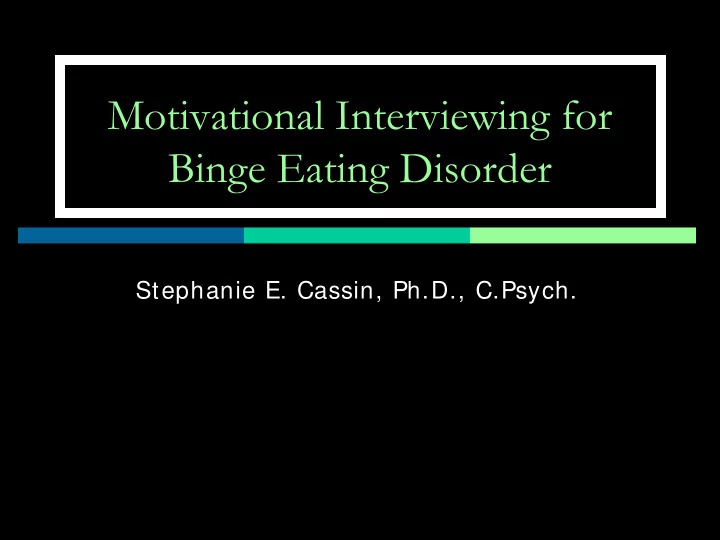

Motivational Interviewing for Binge Eating Disorder Stephanie E. Cassin, Ph.D., C.Psych.
Motivational Interviewing (MI) Developed in the field of addictions Based on the Stages of Change model A non-confrontational approach designed to examine and resolve ambivalence
Principles Underlying MI Express empathy Develop discrepancy Avoid argumentation Roll with resistance Support self-efficacy
Study Rationale: MI for Binge Eating Disorder (BED) Substantial symptom overlap between BED and the addictions for which MI was originally developed. Cassin & von Ranson (2007); von Ranson & Cassin (2007) On average, MI is more effective in changing eating behaviours than in changing drug and alcohol use. Burke et al. (2003) MI reduces the frequency of binge eating to a greater extent than compensatory behaviours. Treasure et al. (1999) BED is a prevalent condition with few treatment options. Grucza et al. (2007); Hudson et al. (2007)
Study Aims To develop a single session motivational interviewing protocol focused on binge eating. To test the efficacy of the motivational interviewing protocol in a sample of women with BED.
Phase I: Development of MI Protocol Discuss interest in study Elicit self-motivational statements Explore ambivalence Discuss “good” things and “not so good” things about binge eating Discuss life areas affected by binge eating E.g., impact on physical health, mental health, finances, relationships
Phase I: Development of MI Protocol Discuss ‘Stages of Change’ Model Brief assessment of client’s stage of change Complete decisional balance Benefits and costs of staying the same versus changing Bolster self-efficacy Past experiences in which the individual has shown mastery in the face of difficulties and challenges
Phase I: Development of MI Protocol Look to the future and explore values Discrepancy between actual life and ideal life, future with and without binge eating Assess readiness and confidence for change Make a change “If you were considering change, how would you go about making changes?”
Phase I: Development of MI Protocol Elicit ideas for behavioural alternatives to binge eating Complete “Plans for Change” worksheet Change plan consisting of small, manageable steps (Treasure & Schmidt, 1997)
Phase 2: Efficacy of MI for BED Participants 108 women Age 18 and over Diagnosis of BED
Recruitment Sources Referred Community Event Computer Radio Database Newspaper/Magazine Television News 0 10 20 30 40 50 % of Total Sample
Procedure Phone screen to determine eligibility In person appointment at university laboratory Pre-intervention measures Intervention Post-intervention measures Follow-up assessments conducted by telephone 1, 2, and 4 months
Intervention Randomized to MI or control group: MI: ED assessment + handbook + MI session ( M = 82 mins.) + letter Control: ED assessment + handbook
Demographics No differences between groups Mean age: 42.5 years ( SD = 12.7) Ethnicity: 89% Caucasian Marital Status: 45% Married/ Cohabiting 32% Single 19% Separated/ Divorced Education: 57% completed college/ university degree 26% completed some college/ university
Baseline ED Variables No differences between groups Mean BMI: 33.2 kg/ m 2 ( SD = 7.8) Mean BED duration: 15.1 years ( SD = 11.6) Mean binge frequency: 14.1 binges/ month ( SD = 7.4)
Stage of Change (URICA) 35 30 25 20 15 MI Control 10 5 0 Pre Cont Action Maintain
Change Ratings 10 9 8 7 6 5 4 MI 3 Control 2 1 0 Readiness Importance Confidence
Self-Efficacy (WEL) 30 25 20 15 10 MI 5 Control 0 Negative Emotions Food Availability Social Pressure Activities
Binge Frequency (per month) 16 14 12 10 8 MI 6 Control 4 2 0 Baseline Month 1 Month 2 Month 4 Note. Significant group x time interaction ( p = .001)
Clinical Significance MI Control Binge Abstinence 27.8% 11.1% Binge Abstinence 27.8% 11.1% No longer have BED 87.0% 57.4% No longer have BED 87.0% 57.4%
Body Mass Index (kg/m 2 ) 40 35 MI 30 Control 25 20 Baseline Month 4 Note. Significant main effect of time ( p = .01)
Depression (BDI) 30 25 20 MI 15 Control 10 5 0 Baseline Month 4 Note. Significant group x time interaction ( p = .001)
Self-Esteem (RSE) 30 25 20 Note. Lower scores = higher self-esteem MI 15 Control 10 5 0 Baseline Month 4 Note. Significant group x time interaction ( p = .003)
Quality of Life (ESWLS) 25 20 15 MI Control 10 5 0 Baseline Month 4 Note. Significant group x time interaction ( p = .02)
Satisfaction with Study 80 70 60 50 40 MI 30 Control 20 10 0 y l t l a l A e h t t w e a l e p t m o m N o o S C
Discussion Self-help handbook alone improved binge eating, but the addition of one MI session significantly improved treatment outcome. Improvement extended to mood, self-esteem, and quality of life. It appears that the strength of MI lies primarily in its ability to enhance confidence for change and self-efficacy.
Funding Provided By
Questions?
Recommend
More recommend